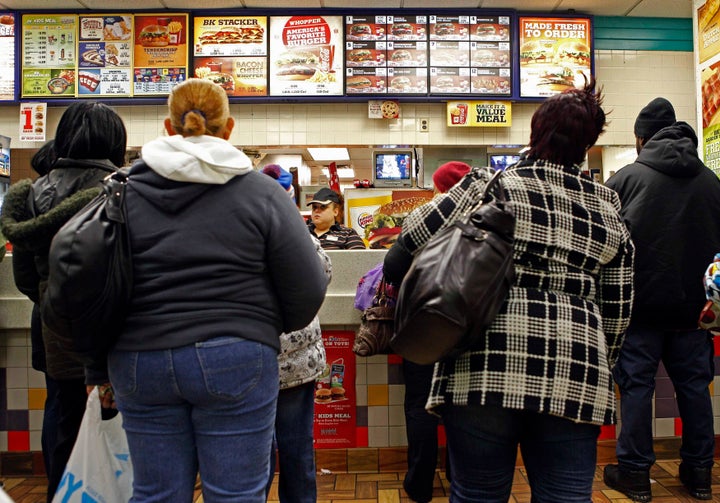It is no secret that America’s profusion of more than 200,000 fast-food restaurants has probably gone too far, forcing us to pay a heavy toll for easy access to all that cheap, convenient and tasty food with still-growing rates of obesity and diet-related, life-threatening conditions like diabetes.
But it’s often overlooked that urban, African American neighborhoods have been disproportionately targeted by the continued expansion of fast-food chains.
According to Chin Jou, an American history lecturer at the University of Sydney, this didn’t happen by accident.
Jou’s new book, Supersizing Urban America: How Inner Cities Got Fast Food with Government Help, details how the U.S. government has helped subsidize the growth of fast-food outlets in minority communities through Small Business Administration grants, as well as urban revitalization and minority entrepreneurship initiatives that prioritize fast-food establishments over other industries.
These efforts — along with a heavy advertising push from the industry itself — have pushed many African American families a long way from the healthier diets of previous generations. As a result, Jou points out, minority communities are disproportionately affected by obesity and related health issues.
African Americans are 1.5 times more likely to be obese than white Americans, according to the Centers for Disease Control and Prevention. These disparities in obesity rates start in childhood. Not coincidentally, fast-food companies are more likely to promote their foods to minority children than to whites, potentially shaping diet preferences from a young age.
It won’t be easy to reverse this trend, especially as the industry increasingly looks to Latino neighborhoods and other minority communities to boost sales. But Jou said there’s hope.
HuffPost recently spoke with the author about how our American diet took such a turn and how to get nutrition back on track — even with a fast food-loving president.
Your book begins with an excerpt from Eric Schlosser’s Fast Food Nation discussing the role the SBA has played in the fast-food industry’s expansion. Why did this capture your curiosity? Why did you feel this was a story worth telling?
I reread the Fast Food Nation excerpt in 2010. At the time, I was studying the history of obesity as a postdoctoral fellow at the National Institutes of Health, so obesity was on my mind a lot. The Fast Food Nation excerpt, which was about the federal government’s loan guarantees to fast-food franchises, struck me because it occurred to me that such policies may have inadvertently and indirectly contributed to the obesity epidemic ― an epidemic that the government was in the process of trying to reduce with initiatives like Michelle Obama’s “Let’s Move.”
The notion that the government may have indirectly contributed to the obesity epidemic was not a new idea ― Michael Pollan is perhaps most famously associated with promulgating the idea that agricultural subsidies for crops like corn and soy contribute to the relatively low costs of processed foods made from these items. But before reading that excerpt, I hadn’t realized that the federal government also supported fast-food franchises through Small Business Administration loan guarantees.
What do you think is the most troubling aspect of the SBA’s fast-food support? Why might readers be alarmed by this?
A troubling aspect of the SBA’s fast-food support (and of the government’s various urban renewal initiatives since the 1960s) is that this contributed to the historical development of what has been called “food swamps,” or places that have a preponderance of fast food and junk food relative to affordable healthy foods. The development of these “food swamps” wasn’t inevitable.

I was struck by how some of the factors contributing to the fast-food explosion in minority communities were often well intended — like the Clinton administration’s Enterprise Zone-Enterprise Community urban renewal initiative. There aren’t really any pure “bad guys” here, are there?
Absolutely, the urban renewal initiatives have been well intentioned, and there are no clear villains in this story. Rather, this is a story of unintended consequences. I don’t know if it would have been easier to write this narrative if there were obvious bad guys, but this is a complicated story that, in my view, did not warrant the drawing out of unequivocally evil characters throughout the narrative.
As you touch in the conclusion, anti-obesity messaging is sometimes critiqued as elitist. How do we combat that tendency, addressing the problem without looking down on people?
You bring up a really important point. First, anti-obesity public health campaigns should not engage in any form of fat-shaming. There have been studies published in prestigious peer-reviewed journals which have found that public health campaigns employing fat-shaming (or “weight stigma”) are actually counterproductive to people losing weight, and can lead to a cascade of pernicious effects, including bullying, stress, depression, and even suicide. Needless to say, fat-shaming is also just plain cruel and sets a bad example for children.
As for how to combat obesity without fat-shaming, I think we need to get away from stigmatizing large bodies and particular food habits, and focus instead on developing policies that make heathy foods more affordable, accessible, and appealing.
These sorts of policies, which you also outlined at the end of the book, would all come with a price tag. Given the political climate, are you at all optimistic these solutions could realistically be on the table?
Facilitating access to healthier foods for all Americans would probably cost relatively little compared to the current administration’s plans for defense spending, business tax reductions, and even the proposed wall along the U.S.-Mexico border.
Even so, I’m not optimistic that healthier diets for all Americans will be a priority for the current administration. We have a president that has not been shy about publicizing his affinity for McDonald’s, KFC, and, of course, the taco bowls at his own Trump Grill, not to mention the fact that his first nominee for labor secretary, Andrew Puzder, was head of the restaurant group that owns Carl’s Jr. and Hardee’s.
The book touches on so many important and timely issues, were you surprised that no one had beat you to this topic?
I was very surprised, which is why I dropped the book project I had been working on and decided to pursue this. While in the last stages of completing my book, I learned that a historian at Georgetown named Marcia Chatelain is working on a book on a similar topic, but focusing on McDonald’s franchise owners and the issue of civil rights. Needless to say, I’m very much looking forward to the publication of her book. Another forthcoming book I’m looking forward to reading is by a professor of Africana studies and human ecology at Rutgers named Naa Oyo Kwate.
By pointing to these two scholars’ work, I am suggesting, of course, that while the development of fast food in African-American communities is one that may have been overlooked by historians and other scholars in the past, that’s no longer the case.
A broader societal shift is taking on poverty in addition to other factors that contribute to obesity. Do you see any other reasons for hope that we might yet make progress on this?
Nationwide and among adults, obesity rates have plateaued or risen slightly for roughly the last decade, depending on which age cohort we’re looking at. But there have also been declines among children in particular age categories, and in particular states, which give some reason for hope, since those children will become adults, of course. The CDC issued a report in 2013 showing that obesity rates fell between 2008 and 2011 among preschool-aged children in 19 states and U.S. territories. The children referenced in this report participated in federal nutrition programs, which points, perhaps, to how investments in improved nutrition by the government can be effective.
The most encouraging development was from a study published in the Journal of the American Medical Association in 2014 showing a 43 percent decline in obesity rates between 2004 and 2012 among children ages 2 to 5. When asked about their response to such studies, obesity experts tended to say that such findings were grounds for optimism, but that there should be continued vigilance and support for childhood obesity interventions. I would share that sentiment.
This interview has been condensed and edited for clarity.
―-
Joseph Erbentraut covers promising innovations and challenges in the areas of food, water, agriculture and our climate. Follow Erbentraut on Twitter at @robojojo. Tips? Email joseph.erbentraut@huffingtonpost.com.

